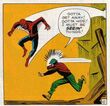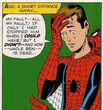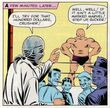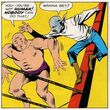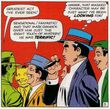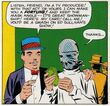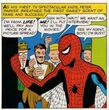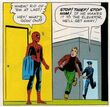Amazing Fantasy #15
Background
A brand-new Amazing Fantasy #15 Lookback!
Ah, who am I kidding? It's the same one we've always had only minus all the extra origin appearances and plus its own (totally obvious) web rating.
Story 'SPIDERMAN!'
Amazing Fantasy #15
| Editor: | Stan Lee |
| Writer: | Stan Lee |
| Pencils: | Steve Ditko |
| Inker: | Steve Ditko |
| Cover Art: | Jack Kirby |
Stan begins the tale by telling us that "confidentially we in the comic mag business" refer to costumed heroes "as long underwear characters!" Steve's splash page shows a gang of happy teens on one side while a sad bespectacled young man stands apart on the other side. But behind this young man, a large shadow looms. A silhouette of a man surrounded by a web with a large spider hanging above him.
One member of the gang of kids says they need "one more guy for the dance" and suggests Peter Parker. A smug-looking teen wearing a blue and white striped sweater (who we later learn is Flash Thompson) scoffs that "that bookworm wouldn't know a cha-cha from a waltz" (your first outdated reference right there, folks!). An attractive blonde girl (who we later learn is Liz Allan) declares Peter Parker "Midtown High's only professional wallflower!"
So, Peter may not be the most popular kid in High School, but his Uncle Ben and Aunt May "thought he was a pretty special lad", joshing with him when it's time to get up in the morning ("Gosh, Uncle Ben, you're worse than a room full of alarm clocks!") and feeding him his "favorite breakfast... wheatcakes". ("Don't fatten him up too much, dear! I can hardly out-wrestle him now!")(Jay Gottfried recently pointed out, "That statement ["hardly out-wrestle him now"] has curious connotations for what happens later in the story, i.e., Peter actually turns to wrestling in his first professional stint as the Spiderman. Seems unlikely that this was a coincidence. Rather I like to think that this was a bit of story foreshadowing on the part of Lee and Ditko, and perhaps even more, part of the (subconscious) reason that Peter/Spiderman gravitates towards wrestling." Jay is an M.D., Ph.D. as well as a Professor at Northwestern University so I'd listen to him if I were you.)
The faculty at the school is also impressed with Peter. A bald mustachioed chemistry teacher who we one day learn is "Mr. Warren" (not Empire State University's "Prof. Miles Warren", the man who eventually became the Jackal, but his brother, as revealed by Kurt Busiek in Untold Tales of Spider-Man '96) tells Pete to keep up the good work "and you're sure to rate a scholarship when you graduate". (And he's right, too.)
But Pete just can't receive any respect from his teen-aged peers. (Maybe it's that "blue pants, black vest, white shirt, red striped tie" outfit he wears all the time. Not the hippest attire, even in 1962.) When he asks a young woman named Sally for a date, she brushes him aside for the blonde "dreamboat", Flash Thompson. (From this one moment, Busiek created the character of Sally Avril for his Untold Tales. Are any of those great stories still a part of Spidey continuity?) Flash swats Pete down, with a stinging "Get lost, bookworm.", (What's the huge "T" stand for on Flash's sweatshirt, anyway? Thompson? Or is he a member of Frankie Lymon and the Teenagers?) and when our shy hero tries to get other kids interested in attending an exhibit at the Science Hall, he is laughed at. ("You stick to science, son! We'll take the chicks!", says one mocker, later revealed to be Seymour O'Reilly.) Peter, in tears and vowing that "someday they'll be sorry", goes to the Science Hall by himself. The title of the exhibit is "Experiments in Radio-Activity."
The demonstration begins. The group stands around a machine of undetermined size which has what looks like two red balloons positioned about a foot apart. The idea is to demonstrate the control of "radioactive rays" as they leap between the two balloons. But a spider descends between the two balloons just as the radioactivity is unleashed. The radioactive jolt kills the spider just as it "bites the nearest living thing" which just happens to be "you know who."
As a result of the bite, poor Peter feels light-headed and flushed. The man who led the demonstration (who also looks like Peter's teacher Mr. Warren but is later revealed to be General Techtronic's Dr. Eric Schwinner in the inappropriately named "Spider-Man: The Final Adventure") observes that the "experiment unnerved young Parker" but it did a lot more than that. Peter wanders out into the street feeling "as though my entire body is charged with some sort of fantastic energy". He is so absorbed in this sensation that he doesn't see the blue sedan barreling down on him. He leaps away at the last instant only to find himself able to stick to the wall of a nearby building. He climbs to the top of the building, then, onto the roof, where he crushes a "steel pipe as though it were paper". He quickly realizes that he has acquired all of the abilities of the biting spider. He returns to the street, trying to think of what to do with "this unbelievable ability which fate has given me."
Only minutes later, he stumbles upon a wrestling exhibition. The sign says "$100 to the man who can stay in the ring three minutes with Crusher Hogan" and Peter decides this is a good way to test his power. He runs home and puts on some old clothes (well, he puts on a white turtleneck sweater but those pants and shoes look like the same things he's been wearing all along). Afraid that he may be "a laughing stock", he disguises himself by covering his head with what looks like a fishnet stocking. Minutes later, he is in the ring, challenging Crusher Hogan. The Crusher thinks he's got an easy mark but, when he moves in, his opponent leaps over his head. The masked man picks Crusher up with ease and scales one of the poles that supports the ring. Crusher, terrified by the whole thing, immediately concedes the match. The crowd loves every minute of it. "Greatest act I've ever seen!", says one. "That mask gimmick gives him just the right touch of mystery", says another. But one man, smoking a cigar and dressed in a purple suit with red bow tie and blue hat, thinks he has found just what he is looking for. As the masked Peter counts his winnings, the man introduces himself as a "TV producer" (who is eventually retconned into an agent named "Maxie Schiffman") and tells the young man that he would "be a smash on the Ed Sullivan show."
At home, Pete decides to really spice up the showmanship by creating a spider costume. Aunt May and Uncle Ben walk in with "some crackers and milk" but don't seem to notice the mask Pete is holding. Alone again, Peter tests his web and web-shooters, which he has quickly whipped up. "Only a science major could have created a device like this!", he says, which is, I think, putting it mildly. He dons his costume, shoots webbing to the ceiling, climbs it, and uses his powers to stick up there. "Okay, world!", he says, "better hang onto your hat! Here comes the Spiderman!" (Yes, that's right. "Spiderman". No hyphen.) So ends part one of the tale, all done in six well-conceived pages.
Part 2
The tale is wrapped up in only five pages, but what a five pages it is!
The new mystery-man in the spider costume appears on TV. He is captured in a spotlight, climbing down a wall. Even the cameraman is stunned. "I'm seein' it with my own eyes," he says, "and I still don't believe it!" The studio audience is overwhelmed, too, as Spidey snuffs a candle and dangles from the ceiling with his web. The TV producer calls a halt to the act. "Don't show 'em too much", he says, "leave 'em beggin' for more!"
At the end of what seems to be Spidey's very own TV special, he is besieged by requests. Life magazine wants a picture spread. An agent wants to put him in the movies. A reporter wants an interview. The already jaded youth gives them the brush-off. "See my agent, boys!", he says, "I'm busy!" Then, still in costume, with his blue pants draped over his right arm, he steps into the most fateful moment of his life.
Out in the hallway, a blonde-haired man runs past Spider-Man with a security guard (later revealed to be named Baxter Bigelow) right on his heels. "Stop him!", the guard yells, "If he makes it to the elevator, he'll get away!" But Spider-Man makes no move to intercede and the fleeing man reaches the elevator and makes his escape. "Lucky that goon in a costume didn't stop me!", he gloats.
The cop berates Spider-Man for not tripping the crook up or holding him or something but the web-spinner thinks nothing of it. "From now on I just look out for number one", he says, "that means... me!"
Back at home, Aunt May and Uncle Ben present Peter with a surprise present... the microscope he always wanted. (May looks plumper than she ever looks again. I suppose Ben's death ends up taking its toll on her.) Peter is overwhelmed with gratitude. "I'll see to it that they're always happy", he thinks of May and Ben, "but the rest of the world can go hang for all I care!"
"In the days that follow, the Spider-Man becomes the sensation of the nation." Pete continues his amazing act while he garners headlines in the nation's papers. "Who is the Spider-Man?", asks the Daily Voice. "Spider-Man plays to packed house!", says The Viewer. "Spider-Man wins showbiz award!", says the Daily Chronicle (I'd like to hear more about that!) "Spider-Man slated for new TV series!", says another paper.
But, then, one evening, Peter Parker comes home to discover a police car in front of his house. The policeman at the car gives him the bad news. "Your Uncle has been shot... murdered!" (Is this the same guy who chased the burglar in the TV studio or is this another "Mr. Warren/Scientist" type example of Ditko drawing two characters who look alike? Turns out he's later named as Officer Bernard O’Brien). The officer tells Peter that a burglar was robbing the house when Uncle Ben surprised him. The burglar killed Ben and fled to the "old Acme Warehouse at the waterfront" (where the Coyote gets all his Road Runner-killing products) where the police have him surrounded. "Your Aunt is next door, the neighbors are looking after her", the cop continues, but Peter isn't thinking of May. He knows the Acme Warehouse, knows that "a killer could hold off an army in that gloomy old place!" But it won't be so easy to hold off Spider-Man!
Quickly, he changes to Spidey and swings across town to the warehouse. Inside the warehouse, the burglar knows that the police don't dare charge him. "All I gotta do is hold 'em off till the moon goes down, then I oughtta be able to slip away in the dark!", he says. But a voice from above contradicts him. The burglar turns to see a costumed figure sticking to the wall ten feet above. Terrified, he turns to run, but Spider-Man leaps past him and blocks his way. He uses his webbing to gum up the burglar's gun, "then my fists will do the rest!" A strong right hand knocks the burglar unconscious.
A cap has concealed the burglar's face but Spidey's blow has removed it. The wall-crawler grabs his opponent by his jacket, lifts him up, and realizes, "It's the fugitive who ran past me! The one I didn't stop when I had the chance!"
Outside, the police decide they must risk charging the warehouse. (And the leader of the cops looks like the same man who gave Peter the news. Could he have possibly gotten there as fast as Spider-Man? And this man is referred to as "Captain" ruling him out as Officer O'Brien.) But no decision is necessary. The burglar is delivered to them, hanging from a huge spider web.
"A short distance away", a distraught Peter Parker (with his mask removed so it can clearly be seen that the mask is sewn to the rest of the costume) knows that it's "all my fault! If only I had stopped him when I could have! But I didn't... and now Uncle Ben is dead..." So, the youth walks off into the night, finally learning that "with great power there must also come... great responsibility... and so a legend is born".
"Be sure to see the next issue of Amazing Fantasy", says the closing caption, "for the further amazing exploits of America's most different new teen-age idol... Spider-Man!" And, as we all know, "Amazing Fantasy" became "Amazing Something-Else"!
Now, for those who haven't ever seen an original or a Marvel Milestone Edition of this comic and have always wondered what the "important message" is that is referred to on the cover, here's your answer. It was an announcement that the magazine could no longer survive in its original format of five short weird Lee/Ditko tales per issue. It told the readers that "Spider-Man" would appear in each subsequent issue, that there may even be two Spidey stories per issue. It also informed readers that the contents page was being dropped to insert an extra page of story and that the word "Adult" was being dropped from the title of the comic. In other words, the whole message became moot as soon as the next issue became "Amazing Spider-Man".
There were three other Lee/Ditko stories in the issue. "The Bell-Ringer!", "Man in the Mummy Case!", and "There Are Martians Among Us!". It would be fun to detail these stories... but not here. Some other time, perhaps.
June 2020: And 18 years later, that time has finally come!
The Bell-Ringer! begins with Stan telling us, “This is the way this little tale was told to us…You may believe or you may not! But of one thing we are certain…you will never forget it!” Why is Stan hedging like this? Because he is treading carefully on some delicate ground, that of religion. The story takes place on “a small volcanic isle” in “the blue Mediterranean.” Almost everyone who lives on the island is a fisherman except for Pedros, who is “the village bell-ringer.” “Every morning for more years than one can count, old Pedros has walked to the ancient church and rung the mellow bells. Old Pedros has rung the bell for all of his adult life, every morning of every week, of every month, of every year. Just as his father did before him and his father’s father for as long as the church has endured.” Everyone seems to like Pedros and appreciates the bells, especially when the fishermen are lost in fog. But one day, the volcano comes alive again. The villagers all realize that they must leave and “find new homes on the mainland.” All except Pedros, who refuses to leave. “Without me, who will ring the bells?” he asks. When told “with the village deserted, none will hear the bells,” Pedros insists that “the bells must be rung” and that “someone may hear.” And so, everyone leaves except Pedros. He goes to the church and rings the bell. Just when the lava is about to engulf the church, a shaft of light shines down and all the villagers in their boats “swear to this day that they saw an aged figure rising up on that shaft of light.” It may have been their imagination “but we prefer to think it was not their imagination! We believe instead that old Pedros was right…someone heard!”
It’s a sweet story on a lot of levels but I can see why Stan hedged his bets. It is interesting the way that people won’t usually object if you write a story with the devil in it but people can get a bit twitchy if you write a story that features God. Stan may have been worried about non-believers feeling that religion was being foisted on them but he may also have been worried about religious people objecting to Pedros being personally rescued by God. I recently had a discussion with a devout friend of mine as to who ever “got out of this world alive.” He said there have been three who have and he sent this to me: “Enoch, Genesis 5:24; Elijah, 2 Kings 2:11; and Jesus, Acts 1:9.” I don’t think he’d be too inclined to add Pedros to his list. Personally, I’m more inclined to wonder why, if God wants to rescue Pedros, he doesn’t just stop the volcanic eruption and allow all the villagers to come back to their homes but, yeah, I get it. It’s a heartwarming story in which goodness and devotion are rewarded and who doesn’t like to see a story like that? Stan needn’t have worried.
Man in the Mummy Case! begins with criminal Rocco Rank fleeing the police. He leaps through a partially opened window. (“Good thing I’m skinny! This window’s open just wide enough,” he says, as if he couldn’t push the window open more if he had to.) When Rocco realizes that he’s broken into a museum (which has such great security that they left a window open), he knows he’ll “stand out like a sore thumb” if the police come around. But a living mummy approaches him and promises to hide him “where your pursuers will never find you.” The mummy proposes to hide Rocco in a mummy case but Rocco balks. “You ain’t makin’ a mummy out of me!” he says. The mummy swears that Rocco will not become a mummy. He also promises that “there is air within and I shall open the case as soon as your pursuers have left!” Rocco gets in and the police show up soon after. (How do they get in? Isn’t there any alarm system at this museum?) One of them, possibly Joe (the only one named), decides to check the mummy case. (The living mummy stands right next to the case, unmoving. Shouldn’t the police wonder what’s keeping him up?) Joe opens the case and finds it empty. The two cops leave and the mummy comes to life again. “I have kept my promise,” he says, “I vowed your pursuers would not find you, and truly you have eluded them!” He then opens the case and says, “Also, I vowed to open the mummy case as soon as it was safe, and this I do now!” (Ah, that tricky mummy!) “Indeed, mortal, you will be safe from your pursuers…forever!” So, where is Rocco? He’s back in ancient Egypt and is now one of the slaves pulling the great stone blocks to build the pyramids. “He’ll never really understand how it happened, but at last he knows where the creaky mummy case led to…and why the living mummy was so anxious to help a frightened stranger!”
I’ll never understand how it happened either. This story prompts so many questions. Such as…what the heck?? There’s a living mummy hanging out in a museum with a mummy case that sends people back into the past. Is this a scheme designed by the ancient Egyptians? “Let’s send a living mummy into the future with a time machine mummy case to get more slaves?” Or is this the living mummy’s idea? Who is this mummy? Why is he alive? How did he get the mummy case? And why does the museum have such frightfully bad security? Does the mummy leave the window open a crack in case a skinny criminal happens by? Are the ancient Egyptians waiting on the other side to enslave victims like Rocco so fast that he’s still wearing his suit coat and turtleneck? Aargh. Let me out of this story and into the next one.
In There are Martians Among Us!, an alien space ship is spotted in the air. By the time a search party arrives in the wooded area where it has landed, the ship is empty. A radio report states that “the ship is believed to have been from the planet Mars! Because its occupants have chosen to flee and hide, we must assume that they are hostile!” A posse tries to track the Martians with bloodhounds. They “know by the arrangement of the instrument panel that the Martians must be human-like in appearance” but they assume there must be “some difference between them and natural Earthlings.” “The search goes on without halt” for a month, with the posse, apparently, still wandering around in the woods. In a nearby city, a man tells his wife to “keep the door locked and don’t open it for anybody” as he goes out. But, discovering she is out of coffee, the woman decides to “dash to the store for a moment.” On the way back from the store in a completely deserted city, she hears footsteps behind…and something captures her. Later, the husband comes home to find his wife gone. Frantic, he makes a telephone call, telling his contact, “She’s ruined everything! The bloodhounds must have got her scent! Now the Earthlings will know she’s a Martian! And that means (Gasp) they’ll be coming after me next!” And as he holds the phone receiver, wipes his face with a handkerchief, and holds two arms out in a gesture of concern, we see how the “human-like” Martian differs from Earthlings: he has four arms.
Those Martians sure must love their coffee! It’s a simple enough twist but it works and it mostly plays fair, though I do wonder where, in her blouse, the wife is hiding her extra arms. Ditko creates a nice contrast between the night scenes of the posse and the bright home of the Martians. As the story progresses, the posse gets darker until they become shadow figures and then, finally, when the wife is captured, just a shadow over her face. In this way, Steve flips the script, making us identify with the well-lit “human” Martians and allowing the twist to do its work. The final panel of the Martian with four arms (who made that four-arm suit for him?) is eye-opening but is also reminiscent of the end of the Twilight Zone episode “Will the Real Martian Please Stand Up?” which aired about a year before this issue. Did Stan or Steve see that episode and decide to riff off....okay, steal from….the Twilight Zone?
My order of these three stories from favorite to least favorite is “There Are Martians Among Us!” “The Bell-Ringer!” and “Man in the Mummy Case!” but I’m not going to bother to give them web-ratings because, well, you know…
Overall Rating 




What, you're not surprised, are you? It's Amazing Fantasy #15! Of course it's a full five webs!
Footnote
Seymour O'Reilly was named in Marvel Knights Spider-Man #8 (2004) after being killed in #7. He's specifically identified in the Official Handbook of the Marvel Universe Volume 11 (2008) as the creep in Amazing Fantasy #15 who instructed Peter to “stick to science” when invited to the science hall exhibit. In the next panel, Seymour was also the one to say, "See you around, bookworm!" as he drove off with Flash and Liz.
Baxter Bigelow was named in the Daily Bugle Civil War Newspaper Special#1.
Raymond Warren and Officer Bernard O'Brien were both given first names in the Official Handbook of the Marvel Universe Volume 11 (2008).
And we're off on our look at every Spidey appearance up to ASM #100! Amazing Spider-Man #1 is next!!!






